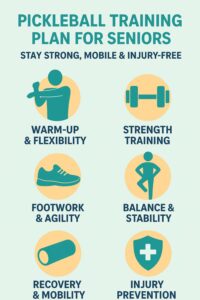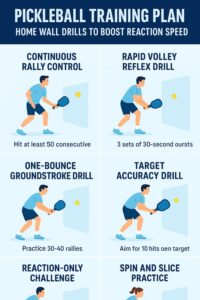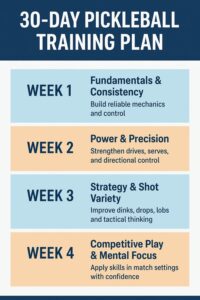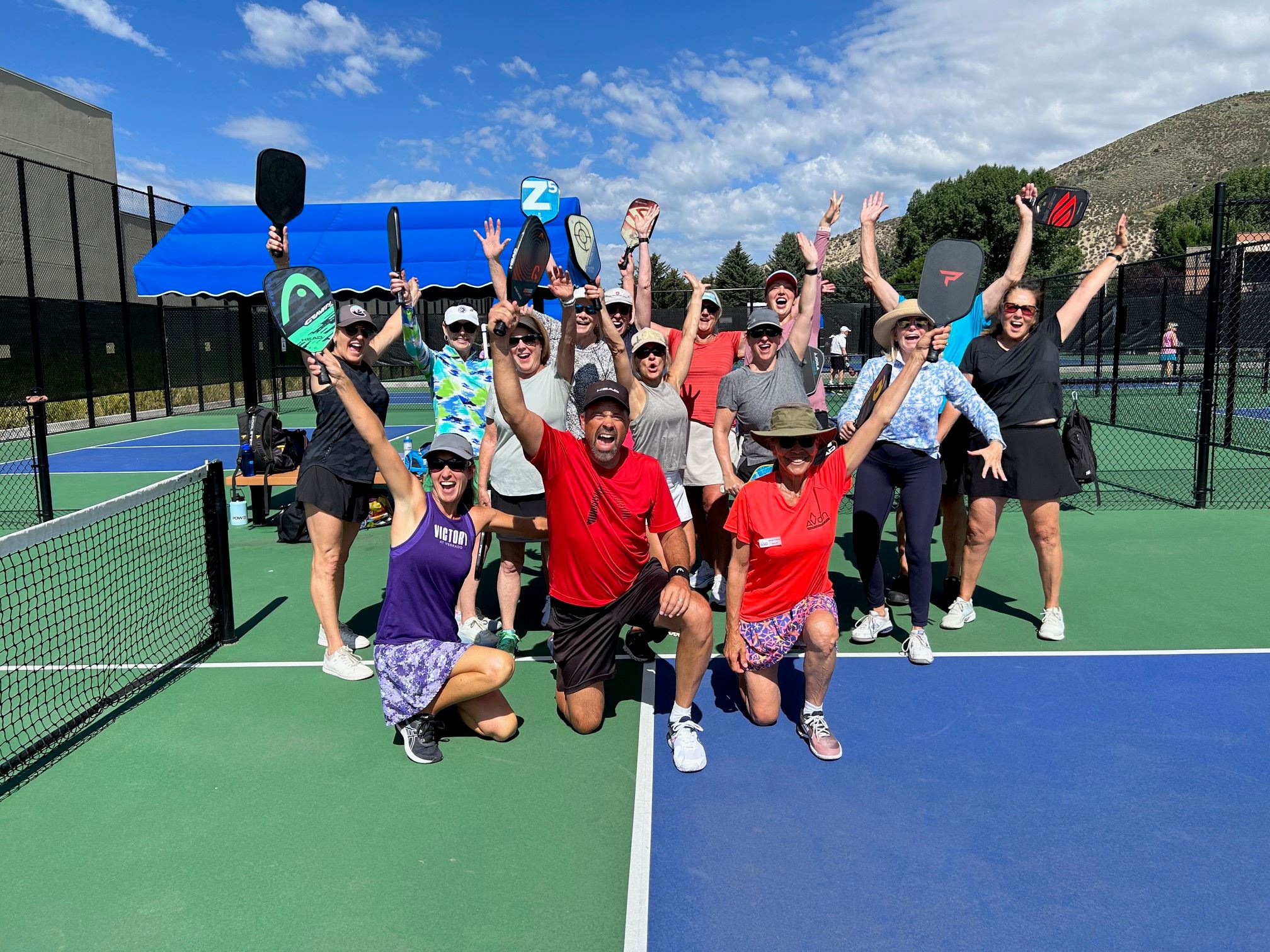
Hot article
Get the latest updates via email. Any time you may unsubscribe
Pickleball has quickly become one of the fastest-growing sports worldwide, attracting players of all ages and skill levels. While the game is easy to learn, mastering the fundamental Pickleball skills is the key to improving consistency, confidence, and enjoyment on the court. Whether you’re just starting out or looking to sharpen your technique, focusing on the basics—grip, footwork, and core strokes—will elevate your game dramatically.
In this comprehensive guide, we’ll explore the essential Pickleball skills every player should know: the correct paddle grips, efficient footwork techniques, and the three fundamental strokes (forehand, backhand, and volley). By the end, you’ll have a step-by-step understanding of how to build a solid foundation and practice effectively for long-term improvement.
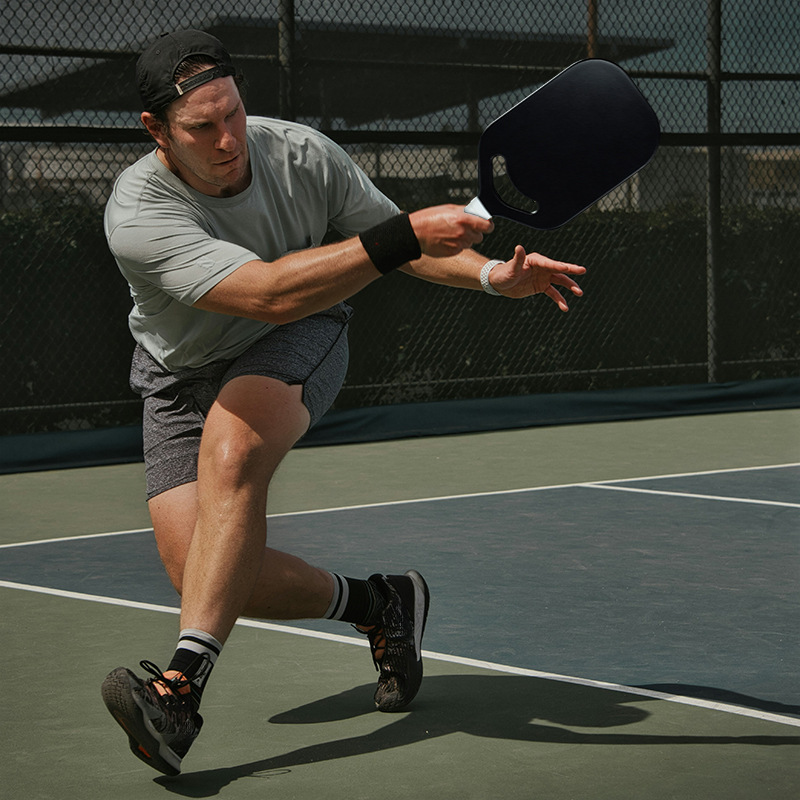
Why Learning Basic Pickleball Skills Matters
Many new players jump straight into matches without taking time to refine their Pickleball skills. While pickleball is accessible to beginners, skipping the fundamentals can lead to bad habits, poor technique, and even injuries.
Mastering the basics of grip, footwork, and strokes offers these benefits:
Consistency: Proper technique increases shot accuracy.
Control: A good grip and footwork give you more control over ball placement.
Confidence: Knowing you can rely on solid fundamentals reduces errors.
Progression: A strong foundation makes it easier to learn advanced strategies.
Whether you play for fun or competition, developing your Pickleball skills ensures you grow as a player.
Pickleball Skills: The Importance of the Correct Grip
Your paddle grip is the foundation of all your shots. Without the correct grip, even the best footwork and swing mechanics won’t produce reliable results.
Forehand Grip (Continental Grip)
The most common grip in pickleball is the forehand grip, also known as the continental grip.
How to hold it:
Place your paddle in your non-dominant hand, face vertical.
Shake hands with the handle, ensuring your index finger knuckle lines up with the paddle’s edge.
Hold firmly but not tightly—your wrist should stay relaxed.
Benefits of the forehand grip:
Works for both forehand and backhand shots.
Allows quick transitions between strokes.
Provides stability and control.
Two-Handed Grip
Some players, especially tennis converts, prefer a two-handed grip for backhands.
How to hold it:
Use the standard forehand grip with your dominant hand.
Place your non-dominant hand above it for extra support.
Keep elbows flexible for mobility.
Benefits of the two-handed grip:
Adds power and stability to backhand shots.
Helps players with weaker wrists.
Improves control for beginners learning backhand placement.
Grip Pressure
An often-overlooked part of Pickleball skills is grip pressure.
Loose grip (3–4 out of 10): Improves touch shots like dinks.
Medium grip (5–6 out of 10): Best for rallies and groundstrokes.
Firm grip (7–8 out of 10): Used for smashes and volleys.
Adjusting grip pressure depending on the situation is a subtle but powerful skill.
Pickleball Skills: Footwork Training
Footwork is one of the most critical Pickleball skills, as your ability to reach the ball depends more on your movement than your swing. Good footwork allows you to stay balanced, move efficiently, and recover quickly between shots.
Side Step (Lateral Movement)
The side step is the most common footwork pattern in pickleball.
How to practice:
Stand in ready position with knees bent.
Move sideways using short, quick steps.
Avoid crossing your feet to maintain balance.
Benefits:
Keeps your body square to the net.
Improves quick reactions for volleys and dinks.
Cross Step
When the ball is hit wider than your reach, use the cross step.
How to practice:
Step your outside leg across your body.
Push off the opposite leg to cover ground quickly.
Maintain balance and return to ready position.
Benefits:
Covers more distance in fewer steps.
Essential for reaching wide shots in doubles.
Recovery Step
After hitting the ball, your movement isn’t complete until you return to ready position.
How to practice:
Immediately push off after your stroke.
Step back to the center or neutral position.
Keep your paddle in front, ready for the next shot.
Benefits:
Prevents being caught out of position.
Improves anticipation for the opponent’s return.
Training footwork drills daily builds speed, agility, and endurance—essential Pickleball skills for competitive play.

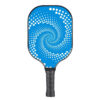
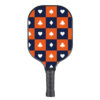
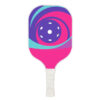
Pickleball Skills: Three Fundamental Strokes
Pickleball has many advanced techniques, but three strokes form the foundation of the game: forehand, backhand, and volley.
1. Forehand Stroke
The forehand stroke is the most natural and powerful shot for most players.
How to perform:
Start with paddle back and knees bent.
Step forward with your opposite foot.
Swing forward with a smooth motion, contacting the ball in front of your body.
Follow through toward your target.
Key tips:
Keep your wrist firm for control.
Hit with a medium grip pressure for accuracy.
Aim deep into the opponent’s court to push them back.
2. Backhand Stroke
The backhand stroke is often a challenge for beginners but is essential for balanced play.
How to perform:
Rotate shoulders and bring paddle across your body.
Step with your leading foot toward the ball.
Swing through smoothly, contacting the ball in front.
Follow through across your body.
Key tips:
Practice with a two-handed grip if you need stability.
Use legs and hips to generate power.
Focus on consistency over strength.
3. Volley
The volley is a shot taken out of the air before the ball bounces. It is crucial at the non-volley zone line.
How to perform:
Hold paddle in front at chest level.
Use a short punching motion, not a full swing.
Keep the paddle face angled slightly downward.
Stay balanced on the balls of your feet.
Key tips:
Control is more important than power.
Keep the ball low to prevent counter-attacks.
Use volleys to pressure opponents at the net.
Drills to Practice Pickleball Skills
Learning theory is important, but repetition builds muscle memory. Here are simple drills for each skill:
Grip drills: Alternate between forehand and backhand grips, focusing on paddle angle.
Footwork ladder: Use an agility ladder to practice side steps and cross steps.
Forehand drill: Hit 50 forehands cross-court, focusing on consistency.
Backhand drill: Rally with a partner using only backhand strokes.
Volley drill: Stand at the kitchen line and volley with a partner, aiming for control.
Consistent practice of these drills develops strong Pickleball skills quickly.
Pickleball Skills Training Chart
| Skill Area | Technique | How to Practice | Key Benefits |
|---|---|---|---|
| Grips | Forehand (Continental Grip) | Shake hands with paddle handle, keep wrist relaxed | Versatility for forehand & backhand shots |
| Two-Handed Grip | Place non-dominant hand above dominant hand | Stability & power on backhand strokes | |
| Grip Pressure Control | Practice switching between light (3/10), medium (5/10), firm (7/10) grip | Better control over dinks, rallies, smashes | |
| Footwork | Side Step | Short, quick lateral steps without crossing feet | Balance & fast reactions |
| Cross Step | Step outside leg across body to cover distance | Efficient coverage of wide shots | |
| Recovery Step | Return to ready position after every shot | Prevents being caught out of position | |
| Strokes | Forehand | Step forward, contact ball in front, follow through | Power & consistency |
| Backhand | Rotate shoulders, swing across body | Balanced play, better defense | |
| Volley | Punch motion at net, no full swing | Control & pressure at kitchen line |
Common Mistakes in Pickleball Skills Training
Gripping too tightly – leads to poor control.
Crossing feet unnecessarily – causes loss of balance.
Hitting with only the arm – instead of engaging legs and core.
Over-swinging volleys – resulting in errors.
Skipping recovery steps – leaving you out of position.
Avoiding these mistakes will fast-track your progress.
Improving Pickleball Skills for Competitive Play
Once you’ve mastered the basics, advancing your Pickleball skills involves:
Practicing shot placement instead of just power.
Developing a consistent serve and return.
Learning advanced footwork patterns for doubles strategy.
Building stamina for long rallies.
Even advanced players return to basics regularly to refine their Pickleball skills.
By focusing on these essential Pickleball skills
Pickleball is fun, fast-paced, and accessible—but success comes from mastering the fundamentals. A proper grip, efficient footwork, and reliable forehand, backhand, and volley strokes form the foundation of all great players.
By focusing on these essential Pickleball skills, practicing with purpose, and avoiding common mistakes, you’ll not only improve your performance but also enjoy the game more. Whether you’re a beginner or aspiring competitor, developing these core skills is the pathway to confidence and consistency on the court.
As a professional pickleball equipment supplier, we recommend combining skill practice with the right gear: comfortable paddles, high-quality nets, and durable balls. Together, these tools and techniques will help you maximize your potential in every match.
POM Pickleball Story
Our brand is called “POM”, and we are committed to providing high-quality sports equipment and accessories for pickleball enthusiasts. We believe that pickleball is not only a competitive sport, but also a lifestyle. It combines the characteristics of tennis, table tennis and badminton, and is suitable for people of all ages and skill levels. Whether it is a gathering with friends and family or a formal competition, pickleball can bring people closer together and enhance mutual understanding and friendship.
“POM” is full of love for the sport of pickleball and a sense of responsibility for the pickleball community. We have gathered a passionate and experienced team, and we have devoted our efforts to every link from product design to production and manufacturing. We not only focus on the quality and performance of the product, but also pay attention to making every user feel the fun of pickleball. Whether it is a beginner or an experienced player, our products can meet different needs, helping every sports enthusiast to break through themselves and enjoy the joy of the game.
Why Choose POM
HIGH END QUALITY:As one of the best pickleball seller, our QC team will ensure every single product you receive are best quality.
PRODUCT DESIGN: Our design department has complete process of making drawings into reality. We also improve your product design based on our years of working experience.
STABLE DELIVERY TIME:As one of the best pickleball manufacturer & supplier,we have sufficient manufacturing capacity, big orders won’t beat us, we can still deliver the order for you in time.
BEST PRICE: We have source factory of pickleball and accessories in China, that’s why we can provide high quality bags with best price.
PRECISE MANAGEMENT:Nothing can be achieved if we don’t implement precise management. We are a company with complete management system.
7-24 SERVICE:As the best pickleball manufacturer, 24-7 immediate response: We’ll receive your feedback to make us a better supplier. We’ll deal with any problems till you feel satisfied.contact us(+86 18902611680)
FAQs About POM
We are a Chinese top manufacturer and our factory is located in Dongguan. Welcome to visit our factory!
• We are a professional pickleball and accessories product provider. We can produce kinds of pickleballs for multi-purpose.
• We provide one-stop services and accept custom designs as your requirements.
• For those who love pickball, our products are for you, whether you are a professional pickball player, or a beginner, you will find the right product!
•Of course, usually we will provide samples for your testing. For custom printed samples, pls send your requirements to us for checking the sample cost.
• It takes about 7 days for sample production.
Yes, we provide free design services, structural design and simple graphic design with your logo.
Sure. We can do any packaging with your design. You can still have your own logo.
Bulk order depending on the order quantity and production details, it will take about 15 to 20 days.
Always a pre-production sample before mass production; Always final Inspection before shipment
• Size, material, printing details, quantity, shipping destination, etc.
• You can also just tell us your requirements and we will recommend products to you.
• By sea, by air or by express.
• If you have your own freight forwarder in China, it is the ex-factory or FOB price.
•CFR or CIF, etc., if you need us to ship on your behalf.
• DDP and DDU can also be used.
• More choices, we will consider your choices.
• The price is determined by the quantity, material, processing method, size and other factors. In addition, due to our continuous
technological innovation, the prices of some of our products are extremely competitive, please contact us to quote.
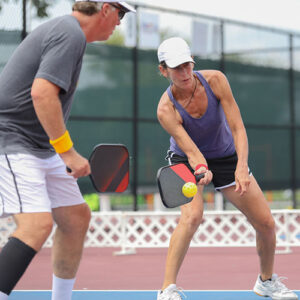
Foreign trade business director
13 years of business experience
Serve well-known brand customers
Any questions, please feel free to contact me immediately!





